Conquering the majestic Huayna Potosí is an exhilarating challenge that draws adventurers from around the world. Over three captivating days, participants embark on an unforgettable journey, navigating breathtaking landscapes and pushing the boundaries of their physical capabilities. From acclimatizing at intermediate elevations to scaling steep snow and ice walls, each step of the expedition demands focus, resilience, and a deep appreciation for the natural wonder that surrounds them. As climbers strive towards the 6,088-meter summit, they’ll uncover a profound sense of personal growth and camaraderie, forever transformed by their encounter with this Bolivian icon.
Good To Know
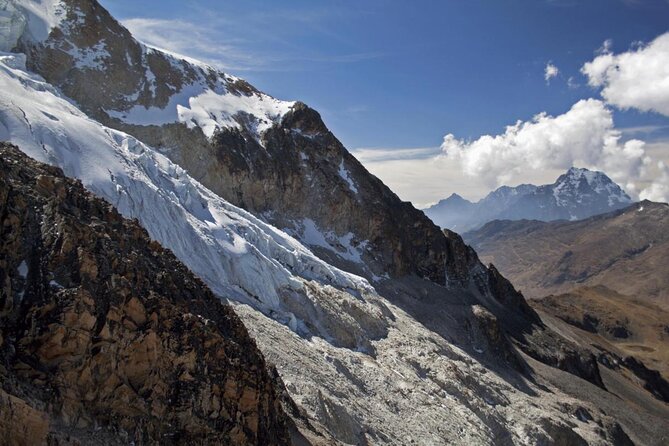
- The expedition to Huayna Potosí, a 6,088-meter peak in Bolivia, is considered one of the country’s easiest 6,000-meter climbs.
- Proper acclimatization and preparation are essential for the strenuous 7-8 hour ascent, which involves navigating ice walls and steep snow.
- Guided expeditions provide qualified guides, quality rental equipment, and a day of training on the lower glacier to ensure a safe climb.
- The summit push starts at 1:00 AM, requiring climbers to overcome extreme fatigue, balance difficulties, and potential altitude sickness at high elevation.
- Reaching the summit offers a profound sense of accomplishment and provides stunning views of Bolivia’s landscapes, fostering personal growth and team camaraderie.
Reaching the Stunning Huayna Potosí

With its towering glaciers and majestic peak, Huayna Potosí commands the attention of adventurers seeking a challenging high-altitude climb.
At 6,088 meters (19,974 feet), it’s one of Bolivia’s easiest 6000m peaks. Multiple routes are available, including standard and more technical options. The stunning glacier views are a highlight, and the peak’s visibility from La Paz airport adds to its allure.
Proper acclimatization is essential due to the high altitude, as is a good level of fitness. The climb can be demanding, with 7-8 hours of ascent a challenge for many.
Yet, with determination and the right preparations, summiting Huayna Potosí offers an incredibly rewarding mountaineering experience.
You can also read our reviews of more tours and experiences in La Paz
Preparing for the High-Altitude Challenge
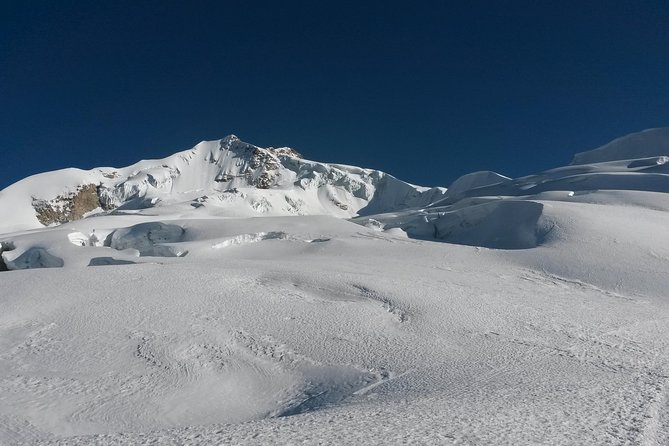
Reaching the summit of Huayna Potosí requires thorough preparation to overcome the high-altitude challenges. Acclimatization is crucial, as the peak’s elevation of 6,088 meters (19,974 feet) can be demanding.
Climbers should expect 7-8 hours of strenuous ascent, requiring proper fitness and determination. The itinerary includes a day of training on the lower glacier and an early morning start for the summit push, navigating ice walls and steep snow.
Qualified guides and quality rental equipment, such as climbing boots, crampons, and sleeping bags, are provided to support the challenging climb.
Reviews highlight the professionalism of the guides and the overall positive experience, making Inca Land Tours a recommended choice for this high-altitude adventure.
Acclimatization and Its Importance
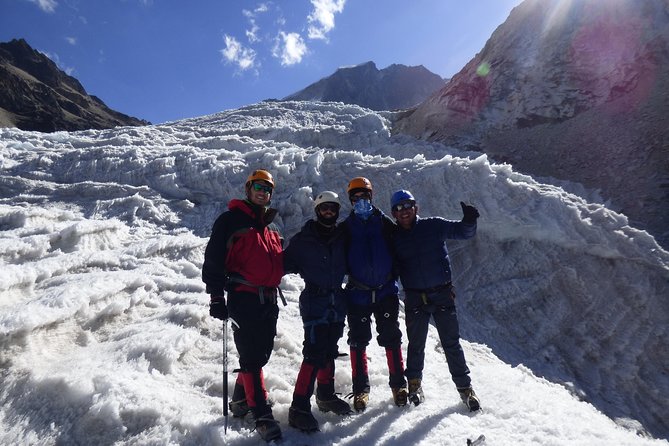
Acclimatization is essential when attempting to climb Huayna Potosí, one of the highest peaks in Bolivia. Situated at an elevation of 6,088 meters (19,974 feet), the mountain poses significant challenges due to the thin air and low oxygen levels.
To ensure a successful and safe ascent, climbers must properly acclimatize to the high altitude. This involves:
- Spending several days at intermediate elevations to allow the body to adapt.
- Incorporating rest days into the itinerary to minimize the risk of altitude sickness.
- Maintaining proper hydration and nutrition throughout the expedition.
Overlooking this critical preparation can lead to severe health issues and jeopardize the summit attempt.
Proper acclimatization is a crucial step in conquering the majestic Huayna Potosí.
Carefully, climbers navigate the glacier terrain on their ascent of Huayna Potosí. The route involves traversing ice walls and steep snow sections. Guides lead the way, ensuring the group moves safely through these treacherous areas.
Crampons and ice axes are essential gear, providing traction and stability on the slippery glacier surface. Climbers must be cautious, testing each step and maintaining three points of contact for stability.
As the group ascends, the terrain becomes increasingly challenging, requiring more technical climbing skills. The early morning start allows climbers to navigate the glacier during the coldest, most solid conditions, reducing the risk of avalanche or crevasse collapse.
Gearing Up for the Climb
Ahead of the Huayna Potosí climb, climbers ensure they’re fully equipped with the necessary gear. The rental package includes essential items like climbing boots, crampons, ice axes, and insulated clothing. This equipment, handled by experienced guides, helps mitigate the challenges posed by the high altitude and demanding terrain.
Key gear to consider includes:
-
Thermal layers: Staying warm is crucial, so packing thermal pants, jackets, and base layers is essential.
-
Sturdy footwear: Durable, insulated climbing boots with good traction are necessary for navigating the glacier.
-
Hydration and nutrition: Carrying sufficient water and high-energy snacks helps maintain energy levels during the strenuous ascent.
With the right preparation and equipment, climbers are well-equipped to tackle the iconic Huayna Potosí.
Ascending to the High Camp
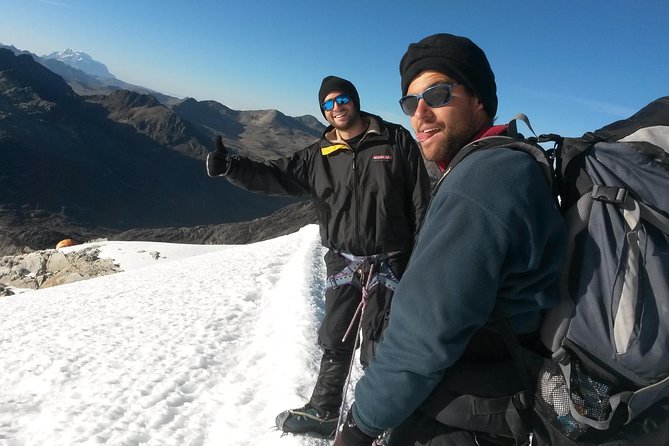
Departing from La Paz early in the morning, the group sets out on the short hike to the high camp nestled at 5,200 meters.
As they ascend, they’re greeted by stunning vistas of the surrounding peaks and glaciers. The trail winds through rocky terrain, requiring careful footing.
Reaching the high camp, they quickly set up their tents and prepare for the early morning climb. With an early dinner and plenty of rest, the team gathers their energy for the challenging push to the summit starting in the wee hours.
Despite the cold, they look forward to tackling the steep snow and ice walls that lie ahead.
The Arduous Summit Push
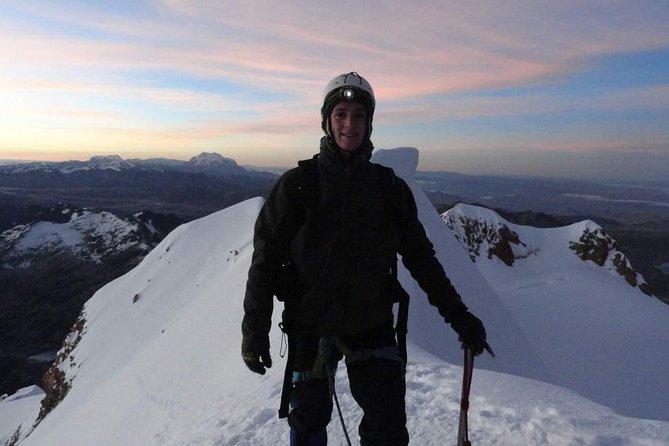
At 1:00 AM, the team rises and quickly gathers their equipment for the summit push.
The ascent through the steep, icy terrain is grueling, and the team must navigate treacherous ice walls and deep snow.
The challenges of the summit push are numerous:
- Extreme fatigue from the long hours of climbing
- Difficulty in maintaining balance and footing on the slippery ice
- Potential altitude sickness due to the high elevation
Despite these obstacles, the team pushes on, driven by the allure of conquering Huayna Potosí’s summit.
The final stretch of the climb demands every ounce of their strength and determination.
Reflections on the Accomplishment
The summit achievement filled the team with a profound sense of elation and pride.
After facing the arduous challenges of acclimatization and the demanding climb, reaching the top of Huayna Potosí was a remarkable accomplishment. The stunning vistas from the 6,088-meter peak were a breathtaking reward, showcasing Bolivia’s magnificent landscapes.
Reflecting on their journey, the climbers felt a deep sense of personal growth and camaraderie, having overcome the obstacles together through teamwork and determination.
This experience would undoubtedly leave a lasting impression, inspiring them to pursue future high-altitude adventures and to encourage others to embark on similar transformative journeys.
Frequently Asked Questions
What Are the Safety Precautions Taken During the Climb?
The tour operator takes several safety precautions during the Huayna Potosí climb, including providing qualified guides, proper equipment, and conducting necessary acclimatization. Guides closely monitor climbers’ fitness and adjust the pace to ensure a safe ascent.
Can the Climb Be Done Without Prior Mountaineering Experience?
While the Huayna Potosí climb doesn’t require prior mountaineering experience, it’s physically demanding and high-altitude. Proper acclimatization, fitness, and determination are essential for a successful and safe summit attempt, even for experienced climbers.
What Are the Typical Weather Conditions Encountered on the Mountain?
The weather on Huayna Potosí can be unpredictable, with sunny skies one moment and sudden snowstorms the next. Temperatures typically range from -10°C to 5°C, requiring climbers to be prepared for harsh alpine conditions.
Is There an Option to Hire Additional Porters or Guides?
Yes, additional porters and guides can be hired for the Huayna Potosi climb. Inca Land Tours offers this option to help carry gear and assist climbers, enhancing the overall experience and increasing the chances of a successful summit.
Can the Climb Be Combined With Other Nearby Attractions or Activities?
The Huayna Potosí climb can be combined with visits to nearby attractions like La Paz’s historic center, the Valley of the Moon, or Lake Titicaca. Tour operators often offer flexible itineraries to accommodate additional activities during the 3-day expedition.
The Sum Up
Climbing Huayna Potosi is a remarkable achievement that challenges both the body and mind. The journey rewards participants with breathtaking vistas, a profound sense of accomplishment, and lasting memories forged through camaraderie and personal growth. This three-day expedition showcases the beauty and allure of Bolivia’s stunning high-altitude landscapes, inspiring adventurers to push their limits and embrace the thrill of mountaineering.
More 3-Day Experiences in La Paz
More Tour Reviews in La Paz
Not for you? Here's more nearby things to do in La Paz we have reviewed
- Private Transportation from La Paz to Cabo San Lucas Mexico
- Hiking in the Balandra Natural Protected Area
- Holy Spirit Island Tour Sea Lions Snorkeling and Beach
- Gray Whale Journey: 10-Hour Tour with 3 Hours of Whale Watching
- Sea Lions & Mega-Paddleboard Tour in Balandra
- Espíritu Santo Private Scuba Tour
- Transportation La Paz Airport – Hotel
- 3 Hours of Guided La Paz Street Food Tour
- Hidden Gems of Sierra Laguna: El Triunfo and Natural Springs.
- Explore La Paz and Paradise Beaches: Balandra and El Tecolote
- Mangrove Adventure with Snorkeling and Shellfish Tasting
- Private Tour to Isla Espiritu Santo and snorkel with sea lions
